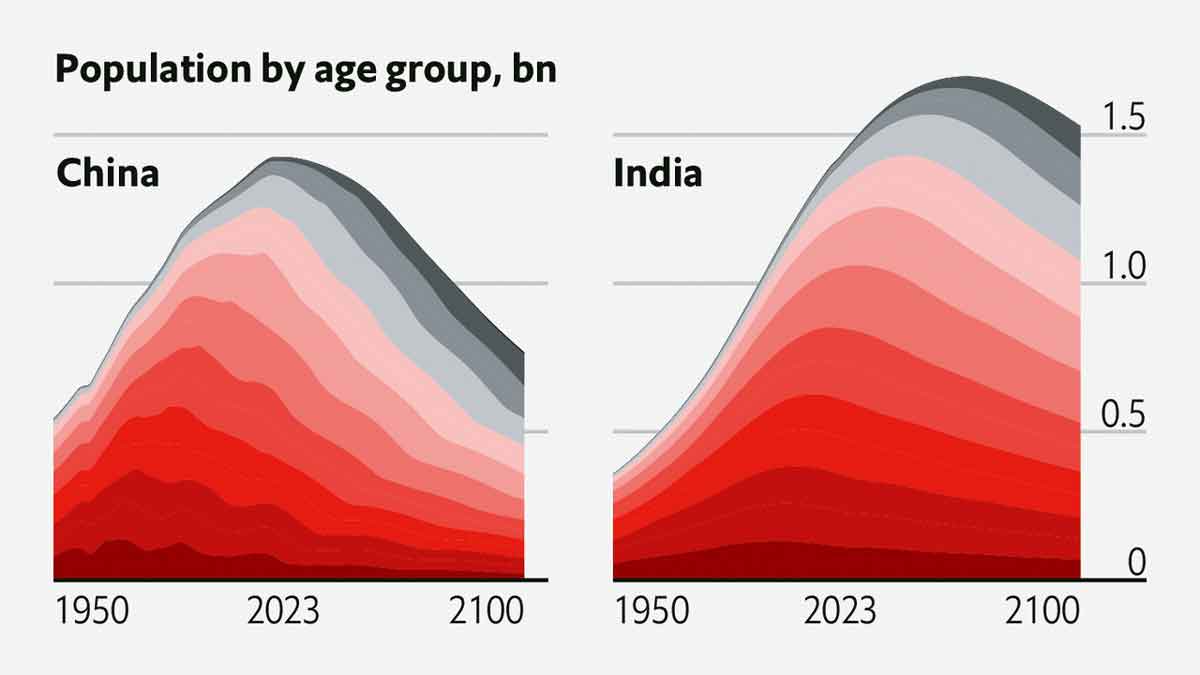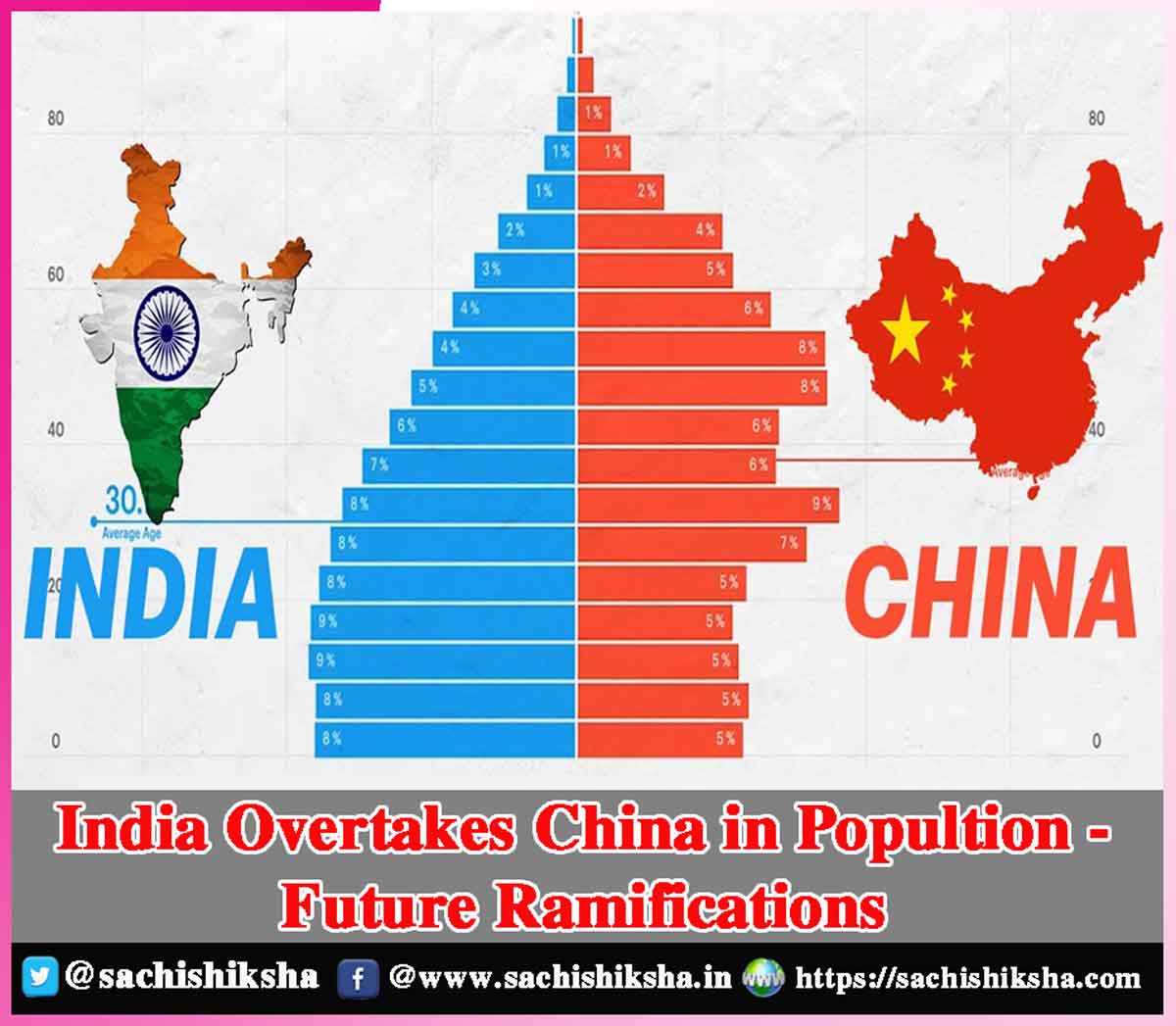India Overtakes China in Population-Future Ramifications
Introduction : Calculating millions of people is difficult at times, because the United Nations reports that India has grown to include a greater population than China, marking an important turning point in world demography that occurred last year.
The majority of the globe has caught up with China as the world’s most populated country, but centuries of stringent rules restricting families to one child have significantly decreased China’s birth rate, enabling India to gain ground.
Table of Contents
Undesirable Title

GDP & Per Capita Income
This expanding population necessitates more job development, infrastructure development, and the provision of educational opportunities, healthcare, and social security, according to Arun Singh, Dun & Bradstreet Global Chief Economist. In that regard, India’s expanding population is undoubtedly an obstacle. To mitigate its effects, the country’s GDP and per capita income must expand steadily. According to an EY India estimate, the Indian economy is anticipated to rise to $26 trillion by 2047, with per capita income increasing six fold to $15,000 (Rs 12.30 lakh) annually. This indicates that the numerator (GDP) must expand at a steady rate while the denominator (population growth) moderates. This will allow the country to more effectively manage its financial assets.
Yearly Census
China and India undertake yearly censuses of population and housing to determine and record their respective populations, and their respective governments utilize the results as they shape their development strategy. In China, the country’s most recent census was conducted. More than a decade has gone by since India’s recent census in 2011. The planned 2021 census in India has been postponed because of COVID-19 pandemic concerns, and it will instead take place in 2024. The United Nations uses essential documents, polls and statistical information to calculate and portray the size of the Indian and Chinese populations in the years following their most recent censuses. According to predictions, the date when India is likely to exceed China in population size is an estimate that will be revised as more data becomes available.
Fertility Rates in India & China
In 1971, China and India had approximately comparable overall fertility rates, with just about 6 births per woman during her lifetime. By the end of the 1970s, the fertility rate in China had dropped dramatically to less than three births per woman. In comparison, India’s decrease in fertility has been relatively slow: it required three and a half decades for India to undergo a comparable reduction in fertility as China did in just seven years in the 1970s. In 2022, China had one of the worlds the lowest rates of fertility, at 1.2 births per woman; India’s fertility rate, at 2.0 births per woman, was barely below the “replacement” barrier of 2.1, which must be met for long-term population equilibrium. According to the latest UN forecasts, the population of India will reach its highest point around 2064 before progressively declining.
Demographic Shifts in India & China
China and India provide different instances of country paths during the demographic shift towards longer lives and fewer households. The timing, speed, and magnitude of the change in demographics have varied significantly between regions and nations, reflecting a variety of human development variables. The main factors include better food quality and overall health, that reduce fatalities, especially for young children; higher levels of education, especially among girls and women, which are frequently linked with lower rates of mortality and fertility; broadened access to of reproductive health-care services, which involves family planning and advancement of women and participation in the workforce.
Indian Efforts to Decrease Population
India has implemented efforts to prevent the rise of big families and decrease population growth, with a National Family Assistance Program launched in the 1950s. However, under India’s federal framework, state administrations were permitted to choose their own policy goals, leading to varying affects across the country. Fertility decreased more quickly and earlier in Kerala and Tamil Nadu, where state governments prioritized socioeconomic development and women empowerment, dropping below the threshold for replacement nearly two decades before the rest of the country. India’s smaller human capital investment and lower economic growth in the 1970s and 1980s resulted to a more gradual drop in fertility than China, resulting in more rapid and sustained population increase.
Population Aging in India
Population aging occurs slower in India than in China, and at varying rates between states. Overall, in India, the total number of adults aged 25 to 64 exceeds children and youth under the age of 25 by about 20%. The total number of working-age individuals is expected to increase both in quantity and as an amount of the overall population by mid-century, guaranteeing that demographic change continues to contribute positively to overall economic output. Furthermore, worker immigration from the younger northern and eastern states may increase the size of workers in the somewhat elderly southern states, extending the social dividend in those areas.
Sex Ratio Imblance in India & China
Both China and India have sex ratio imbalance at birth, with a million more boys than girls born since the 1980s. These distorted percentages are driven by a high desire for sons, which is mostly accomplished by sex-selective abortion, which is illegal in both nations. In some parts of India, post-natal inequality persists resulting in greater mortality rates for girls than boys, compounding the gender disparity. In 2023, China has 116 men for every 100 females, whereas India has 110 males for every 100 females. Such inequalities may provide issues for adult partnerships and creation of families, with negative effects for social connections and inter generational assistance, particularly in areas where the ancestral family-household is the primary source of assistance and care for the elderly.
Elderly People in India & China
The number of elderly people is quickly increasing in both China and India. This increase is attributed to an increase in births during the middle of the twentieth century, as those generations are currently reaching longer ages, as well as lower mortality rates, which allow greater numbers of individuals to live to later years. Between 2023 and 2050, the number of people aged 65 and older is predicted to nearly double in China and more than twice in India, creating significant threats to the capacity of health and social security system.
Effects of Population Control on Southern & Northern States
A lot southern politicians have voiced focus that their achievements in reducing population numbers through educational initiatives, birth control, and increased literacy will result in a decrease in their representation in parliament, as well as further political dominance by the states in the north, which are still experiencing population growth.
Conclusion
India’s median age is currently 29, and the population of the nation will remain predominantly young for the next two decades. A comparable “demographic dividend” was extremely beneficial in China, resulting in a financial boom, especially with respect to manufacturing. While India has one of the largest economies in the world, analysts have underlined that the country requires additional investment in schools and employment to capitalize on the opportunity given by its youthful population in coming centuries.












































